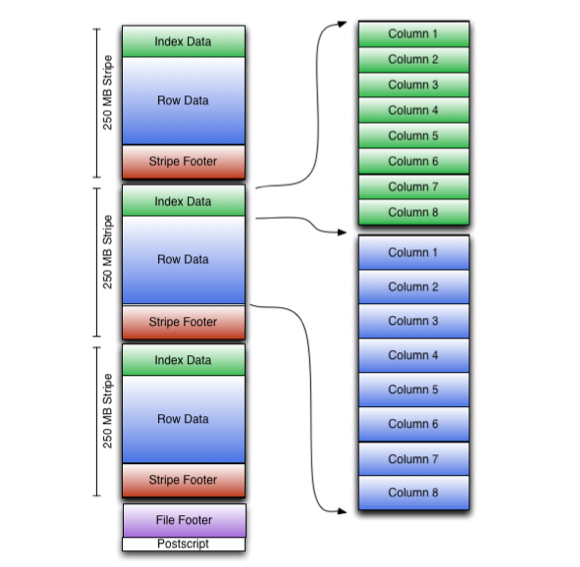The Optimized Row Columnar (ORC) file format provides a highly efficient way to store Hive data. It was designed to overcome limitations of the other Hive file formats. Using ORC files improves performance when Hive is reading, writing, and processing data. The Optimized Row Columnar (ORC) file format provides the following advantages over many other file formats:
Efficient compression: Stored as columns and compressed, which leads to smaller disk reads. The columnar format is also ideal for vectorization optimizations in Tez.
Fast reads: ORC has a built-in index, min/max values, and other aggregates that cause entire stripes to be skipped during reads. In addition, predicate pushdown pushes filters into reads so that minimal rows are read. And Bloom filters further reduce the number of rows that are returned. Proven in large-scale deployments: Facebook uses the ORC file format for a 300+ PB deployment.
File Structure
An ORC file contains groups of row data called stripes, along with auxiliary information in a file footer. At the end of the file a postscript holds compression parameters and the size of the compressed footer.
The default stripe size is 250 MB. Large stripe sizes enable large, efficient reads from HDFS.The file footer contains a list of stripes in the file, the number of rows per stripe, and each column's data type. It also contains column-level aggregates count, min, max, and sum.
This diagram illustrates the ORC file structure:

Stripe Structure
As shown in the diagram, each stripe in an ORC file holds index data, row data, and a stripe footer. The stripe footer contains a directory of stream locations. Row data is used in table scans.
Index data includes min and max values for each column and the row positions within each column. (A bit field or bloom filter could also be included.) Row index entries provide offsets that enable seeking to the right compression block and byte within a decompressed block. Note that ORC indexes are used only for the selection of stripes and row groups and not for answering queries.
Having relatively frequent row index entries enables row-skipping within a stripe for rapid reads, despite large stripe sizes. By default every 10,000 rows can be skipped.
With the ability to skip large sets of rows based on filter predicates, you can sort a table on its secondary keys to achieve a big reduction in execution time. For example, if the primary partition is transaction date, the table can be sorted on state, zip code, and last name. Then looking for records in one state will skip the records of all other states.
A complete specification of the format is given in the ORC specification.
No comments:
Post a Comment